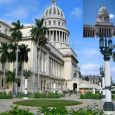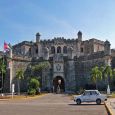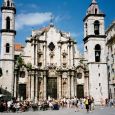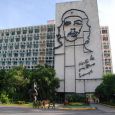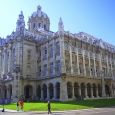Havana
Advertisement
By plane
Jose Marti International Airport (IATA: HAV) has three separate terminals. Terminal 1 is for internal (domestic) flights, Terminal 2 is mainly for charter flights from the USA and Terminal 3 is used for all other international flights.
Customs officials can be very strict, and will probably snoop out any suspicious electronics or other items. Customs officials and immigration officials also work slowly and baggage reclaim is very slow, so expect a very long wait when entering the country.
The local airline, Cubana de Aviación offers a good service.
By train
Most trains in eastern Cuba have been suspended due to poor track conditions. Only the following trains were operating to Havana in September 2007. All services run on alternate days only.
The express Tren Frances, overnight from Santiago de Cuba via Matanzas, Santa Clara and Camagüey every other day (note that several hours have recently been added to the schedule due to the poor track conditions).
An overnight local train from Santiago de Cuba, operating on alternate nights when the Tren Frances does not run.
An overnight train from Moron with stops in Matanzas and Santa Clara.
By boat
Due to political circumstances, it is difficult to enter Cuba by sea. Visiting mariners need to make arrangements in advance of entering port to avoid difficulties. Also, most ports are closed to unauthorised visitors.
By car
Hiring a car in Cuba will cost you from 33 to 106CUC per day. The car will have a special tourist plate, which means you will be required to give generous tips every time you park your car in a crowded place. Taking into account the all-around unreliability of Cuban transport, hiring a car can be the right choice for those who don't want any hassle whatsoever. Please keep in mind that picking up hitchhikers is almost a moral obligation for the "aware" tourist, especially when travelling between cities. Picking up a hitchhiker can be the best way to arrive to your destination without getting lost.
By bus
Viazul operates an inter-city coach service to/from most major destinations including Camagüey, Cienfuegos, Matanzas, Pinar del Rio, Sancti Spiritus, Santa Clara, Santiago de Cuba, Trinidad, Varadero and Viñales. The main Viazul bus terminal is 3km southwest of central Havana. Departing buses also stop at the central (Astro) bus terminal, but arriving buses do not. If you are using the central bus terminal, you buy tickets and wait for the bus in a separate air-conditioned office near the west entrance of the terminal. Schedules are posted on the Viazul website.
Astro can get you from Havana to almost anywhere in Cuba.
Plaza de Armas
Spacious and elegant, the square is surrounded by baroque constructions that give it a authentic colonial milieu. It was laid out during the 1600s, replacing an old plaza which acted as the center of religious, administrative and military activity. Until the mid-18th century, it was used for military exercises and parades. After its remodeling between the years 1771-1838, it became a favored meeting spot for the city's wealthy. Today it is also known as Céspedes Park, in honor of the country´s Founding Father, whose monument stands at its center. This square is one of the most outstanding in the city, enlivened by vendors of antiques and classical books on Latin American and world literature. Attractions of remarkable historical value lay around the square such as the capok tree (Ceiba) under which the first mass for the city´s founding was officiated in 1519
Castillo de la Real Fuerza
Plaza des Armas. Castillo de La Real Fuerza is the oldest bastioned fortress in the New World and has now reopened as a Cuba’s premier maritime museum. (There is also a small naval museum in Cienfuegos.) The museum contains excellent exhibits of Cuba’s maritime past, from pre-Columbian days through to the 18th Century with the Royal Shipyard of Havana, one of the largest in the world which built nearly 200 ships for the Spanish Crown. The museum features a huge four metre model of the Santisima Trinidad, located on the main floor with a large interactive touch screen, which describes life aboard an 18th Century ship-of-the-line in Spanish, French, and English. The original ship was launched into Havana Bay on March 2, 1769 and was the largest ship in the world in the 18th Century, with 140 cannons on four gun decks. She was one of four Cuban-built ships at the Battle of Trafalgar in 1805. Downstairs you will find ancient navigational instruments, underwater archaeological artifacts, and gold and silver from the colonial era. Also note the original weathervane, La Giraldilla, while her replica moves in the breeze on the top of the fortress tower, which commands a fantastic view of the city. The second level of the museum hosts many other historic and contemporary models of ships with links to Cuba and is also a good location for viewing the harbour and city skyline.
Plaza de la Revolucion
Huge square dominated by a statue and monument of Jose Marti and the iconic image of Che Guevara adorning the Ministry of the Interior. Arrive either early or late, as it is often swamped by tourists and gets very hot during the day.
Information not available


